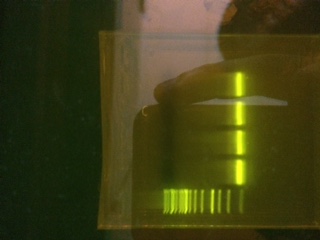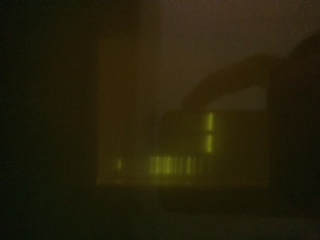Team:UCLA/Notebook/Protein Cages/21 July 2015
Nithin's Notes
PCR to add the iGEM suffix to our PcQuad was done. We used igem prefix 1 and igem suffix 2 to run the reaction. The template DNA was obtained through the dna extraction that was done yesterday. This product was diluted to give us a 20ul tube of 1ng/ul. I loaded 500 ng of template for a 50 ul reacton. After running the gel, we werent able to see the band that we wanted. But, we did see the same nonspecific band that had haunted us earlier shining ever so brightly.
I did change the annealing time from 25 seconds to 30 seconds for this reaction.
Lane 1: Ladder
Lane 2-5: 25ul of the same reaction with same conditions.
Phillip's notes:
Introduction: The PCR product from yesterday will be used as a template for the amplification reaction today. If the amplification is successful, RE digestion, and possibly ligation, will also be done today.
Procedures:
Amplification:
Nithin ran the amplification, and made the agarose gels.
Observations: The gel appeared to have no band at the desired product size, and only a very strong non-specific band. The non-specific band was the same band that appeared in the previous PCR with the iGEM prefix and suffix #1 primers. It was noted that the annealing time was set to 30sec, instead of the extension time.
Rerun of the amplification: From the PCR product of the initial amplification, 10uL of 1ng/uL stock was made using 0.635uL of 15.75ng/uL DNA. The extension time was made to 30sec, and the annealing time was returned to 20sec.
A master mix of the following was made. 10uL 5x reaction buffer 5uL 2uM dNTP 2.5uL primer igem prefix 2.5uL primer igem suffix #2 0.5uL of template (1ng/uL) 0.5uL of Q5 polymerase. Water up to 50uL.
The remaining PCR conditions were the same as previously, 2015-07-20. The product was ran on a gel in two 28uL fractions, with 6x loading dye added. Both lane 1 and 2 are the same.
Observations: The gel showed the same result as the one Nithin ran. There was no product at the expected size, and only the ~300bp non-specific product was observed.
Conclusions: Michael suggested to try to run a temperature gradient again. That will be attempted when reagents come in.


